Burma Link | November 11, 2014
Tar Aik Bong is a leader of the Ta’ang (Palaung) people, one of Burma’s ethnic nationalities that continues a daily struggle for survival in largely inaccessible areas in northern Shan State. He joined the Ta’ang liberation movement in 1987, and currently serves as Chairman of Palaung State Liberation Front (PSLF) and Head of the military commission of Ta’ang National Liberation Army (TNLA). TNLA is one of the few ethnic armies that continues to fight against the Burma army and vows not to lay down arms until equal rights and a lasting political solution is achieved. TNLA fights to “obtain freedom for all Ta’ang nationals from oppression, to form Ta’ang autonomous regions that guarantee democracy and human rights, to oppose and fight against dictatorship and any form of racial discrimination, to attain national equality and self-determination and to establish a genuine Federal Union that guarantees Ta’ang autonomy and to eliminate cultivation, production, sale and use of narcotics.”
Tar Aik Bong is also a member of the ethnic alliance United Nationalities Federal Council (UNFC) council and Foreign Affairs Department. In an exclusive interview with Burma Link, Tar Aik Bong talks about the causes and current situation of the Ta’ang conflict, the role of the UNFC, and the brutal tactics that the Burmese military uses against Ta’ang civilians in order to cut the opposition movement. Tar Aik Bong also discusses the Burmese military’s instrumental role in the epidemic drug usage in Ta’ang areas, and TNLA’s plan to eradicate the drugs.
Burma Link (BL): How has the conflict changed since the new government came to power in 2011?
Many people said that U Thein Sein’s government is trying to bring about peace among the ethnic armed forces, and his government holds that peace is essential in order to bring change in Burma, but his government lacks the skills and sincerity in managing political dialogue with the PSLF, and also there are have been no plans to hold further talks with PSLF since the last state level talks that were held in July 2013.
U Thein Sein, when he was SPDC’s
BL: Could you briefly describe the current conflict situation in Ta’ang areas?
Almost in every day, armed conflict is still taking place between the Burma army and TNLA. This is because there are more than 50 Burmese battalions moving around the Ta’ang region since 2011. The latest battles took place on the 4th and 6th November respectively. There were two battles between a regiment of TNLA under brigade 3 and Myanmar army division 77 which left 8 Myanmar soldiers dead and 12 others, including a lieutenant, seriously wounded.
The Burmese army continues to increase its forces and gearing up its offensives in the Ta’ang regions of Nam San, Man Tong, Nam Kham, Namtu, Kut Khai, Kyuak Mae, Tibaw, Moe Goke and Moe Make Townships in order to assert total control of all the Ta’ang territories. That cannot be accepted by PSLF and the Ta’ang people. There are not only regional battalions such as north-east military command, regional military command, andstrategic operations command, but also divisions 77, 88 and 99 are joining in offensive attacks in the Ta’ang region since 2011. Army division 77 is the notorious troop that brutally crushed the Buddhist monks’ peaceful Saffron protests during 2007.
The army offensives targeted the re-united and reformed TNLA, Ta’ang armed forces, that had grown rapidly through the full support from our Ta’ang people and alliance groups. Burmese troops are continually trying to block Ta’ang people in supporting PSLF/TNLA by capturing them in the battle fields; they are tortured, killed and accused of being directly connected with TNLA forces.
As a consequence of 50 battalions of the Burmese military moving into the area, the following human rights abuses on the innocent Palaung people have broadly and continuously occurred, including torturing, unlawful arrests, killings, rape, forced marriage, occupying and destroying peoples’ properties, occupying farmers’ farms and building army camps, using forced labor on military farms, road constructions, and unlawful tax levying are the violations that are continuously taking place.
Sometimes, the local people have to search and send food to the Burmese army, inform them daily on the moving of ethnic forces, and carry out security duties for the army. If somebody is discovered absent, the village-heads are to be punished by various means.
BL: PSLF/TNLA fights both against drug trade and for national liberation. In what ways does the PSLF/TNLA fight against drugs? In your opinion, what is the government/Burma Army’s position with the regard?
The main aims of PSLF/TNLA are to attain national equality and self-autonomy, but, due to the current increasing in opium plantations and drugs smuggling and drug addiction issues in the region, the TNLA has to operate these two objectives jointly: a war on drug eradication and, at the same time, national liberation.
In August 2012, the PSLF Central Committee meeting set up a 5 year plan. We started our first phase of a five-year plan for the eradication of drugs in August 2012 and we are satisfied with our drugs eradication program thus far and plan to continue its implementation.
Firstly, we educated local opium farmers about the dangers of the drugs and counselled them not to grow it. We also warned them that we will take action on continued cultivation as per our drugs eradication policy leaflet. This phase took about 5-6 months to implement. We did not take personal actions on farmers, but we did destroy their poppy plantations and we warned them not to grow opium again in the next year. After that, we took serious actions on the drug traffickers. For drug users, we sent them into TNLA rehabilitation camps where our TNLA medics were there to take care of them using our own funds.
As TNLA was trying to deal with drug related problems, head-on clashes occurred frequently with the Burmese army and its people’s militia forces. On the 4th Nov 2014, the fighting occurred because the Myanmar Army obstructed our column of TNLA troops that were on their way to organize farmers not to grow opium poppy during this growing season. We believed that it will be more affective to organize the people not to grow the opium poppy at this time, rather than destroying their opium in the fields during the produce season so they have the alternative to yield another type of crop for their livelihoods.
The government continues to turn a blind eye and does not take an action despite signing many international anti-trafficking treaties pledging their commitment to fight against the drug trade in Burma, again paying lip service to an international audience while, in reality, the people continue to suffer the detrimental effects of narcotics. At the same time, the Burmese troops have allowed its militias to plant opium and trade drugs for a long time.
Burmese army and police forces that are based in Man Ton, Namtu, Kut Khai, and Nam Kham levied opium tax illegally during their duty in these regions. The drug smugglers are kept close and aided by the leaders of people’s militia groups, so that there are no actions on the drug smuggling gangs by Burmese army. That is why drug production and use are still increasing in the Ta’ang region.
We noted that if we do not take serious action against drug issues, nobody else will need to kill the Ta’ang people as they will ruin themselves and die of drug related issues such is the spread of the problem. That is why, in the last two years, we were able to destroy more than 1,000 acres of opium farms in Ta’ang regions and have seized large amount of drugs in our regions and burned the drugs that we were captured. No matter how the Burmese army and its local militias have continued to block our drugs eradication programs, we will continue to implement our eradication policy as much as we possibly can.
With support from our Ta’ang people and international communities, the PSLF/TNLA strongly believes that we can meet our goals on the war on drugs and national liberation movement soon.
BL: When did you see a shift to greater opium cultivation and addiction? Why do you think the drug problem has become worse in Ta’ang areas?
There is a long history of opium in Palaung areas and it has been grown there for many years ago. However, by the end of the 1990s and into the 21st century, cultivation and addiction increased rapidly. Many opium farmers quoted that the rise in the number of opium plantations started after the decline of tea production in 2006. The facts which have led to the increase in opium plantations are that planting other crops is difficult, especially in the remote areas and areas with poor transportation links. So they see planting opium as an easier option in order to earn more money and to transport.
In the past, poppies would be grown on small plots of land cleared in the forest. Today, there is less emphasis upon finding discrete production sites. Indeed, larger poppy farms are owned by Burmese Militia groups under Burmese army control. Most Palaung villagers are now laborers working for Militia owned poppy farms, alongside or instead of their own cultivation. Poppy farm laborers can get as much as 5,000 – 6,000 kyat per day. Closer to the border daily wage rates are even better and are paid in Chinese Yuan. Last year, we issued a statement urging the Ta’ang villagers not to go for work in poppy farms and anyone found doing so would be held accountable. But some villagers still went to work at Burmese militia owned poppy farms because they still earn good daily incomes as employment is scarce and working on these farms is easy money for a vulnerable and extremely poor population.
However, it will take many years to tackle this problem because in the last 10 years, there were few plantations and few drug users, but now it is inversely related to previous years. If we entered into drug users villages, we can easily find 80 out of 100 houses inhabited by drug users; 80% of young people in these villages are drug users. All of them are victims of drugs and the drug trade. In order to help them to recover from their addiction and to eradicate drugs in our area, we need a longer timeframe and international support in tackling this issue.
Another reason for the spread of the problem is that drugs are offered as financial payment through which to mobilize and maintain local militias in an area where the Burma Army’s resources were already thinly stretched. Rather than providing direct payment, the Burmese army has effectively allowed militia groups to control the lands to grow opium which they have been given license to generate income in whatever ways they like. According to the interests and benefits both for the Burmese military, and militias groups, they let all opium farmers and producers freely operate and participate in the stages of narcotic production in the Ta’ang regions. For some militias, this has facilitated the continuation of decades-long involvement in drug trafficking, whilst for others it has offered a privileged opportunity to become new players in the drug trade under the military control.
Therefore, the drug problem becomes one of our main enemies of all our Ta’ang people; together with the people, we must destroy it to make our Ta’ang new generation free from the drugs. That is why making all drug problems disappear in the Ta’ang region, has become a national cause to participate in drug eradication operations in all ways and by all means.
BL: What is the biggest current challenge for PSLF/TNLA and Ta’ang people?
The biggest challenges to PSLF/TNLA and Ta’ang people are about regional stability and regional security threats by the Burma army and other armed groups.
Withdrawal of the Burma army from Ta’ang territories and the granting more self-autonomy are our biggest challenges in the future. Even though most of ethnic armed groups have signed ceasefire agreements, there are still clashes taking place as government troops are still increasing their troops into their ethnic territories and still attacking them. As long as the Burmese military is still active in the ethnic areas, then armed conflicts will never stop. That is why securing the withdrawal of the Burmese troops from the entire area is the biggest challenge for us.
Please let me add a few words in this regard. We, PSLF/TNLA will try our best to protect the dignity and prosperity of our people. TNLA will never carry out any offensive wars against invading Burmese army and other armed groups, but take defensive positions to protect our people. But if there is Burmese army or any other armed group’s launching offensive attacks on us, we will defend our people and our mother land with our lives.
BL: What are the root causes for Ta’ang resistance movement?
The root causes for the Ta’ang resistance movement can be traced back in accordance to history. The Ta’ang (Palaung) people were part of the Mon-Khmar race and the first settlers in the region of Burma/Myanmar. Ta’ang (Palaung) people at that time were independent and self-sufficient.
Over a hundred years ago, the Taung-Paing Saw Bwa (Regional Governor) governed the Ta’ang race. Palaung Saw Bwa Khun Pan Sein, the last Saw Bwa of the Ta’ang people, was one of the leaders endeavoring to sign the Pang Long Agreement, the main source of the reunification of old Burma. The Taung-Paing Saw Bwa who governed the hilly regions of the Ta’ang people was the person who had a clear view on the current political trends of Burma. In 1961, he relinquished the throne and concluded the feudal governing system.
In the years of colonization in the southern regions, the Ta’ang people, together with other ethnic races, fought against the invaders. In the years of fighting for the Independence of Burma, Taung-Paing Saw Bwa Khun Pan Sein tried collaborating with General Aung San who was the pioneer of the struggle for independence. To work through activities for national indication by peaceful means, he formed the Palaung Nationalities United League in 1946, but it was abolished by the Revolutionary Council, the military regime, in 1962.
Palaung National Force or PNF was formed on the 12th of January 1963. In 1976, the PNF was reformed as PSLA under the leadership of Chairperson Tar Khon Thaung. The PSLA laid down policies on the military, political, and organizational affairs under strong leadership and avid determination. Through the launched military offensives of the military regime under the four-cut operations a cease-fire agreement had to be made on 21st of April 1991. Through cunning manipulation, the State Peace and Development Council or SPDC, finally, forced the PSLA to surrender arms in April 2005. This is a time that we recognize with sorrow. The resistance movement for the Ta’ang people throughout history has been about gaining freedom, self-determination and recognition in Burma.
BL: What are the reasons for forming PSLF/TNLA in 2009?
First, please let me explain a little bit about forming The Palaung State Liberation Front (PSLF).The PSLF was formed in 1992 by those leaders within the PSLA who rejected the decision of mother organization to sign the ceasefire agreement with the Burmese military government in 1991.
After the cease-fire agreement was signed between the PSLA and SPDC, some PSLA members, including me, remained at Manerplaw, the headquarters of ethnic armed forces and democratic organizations. We decided not to return to our mother organization and instead joined with the National Democratic Front (NDF) and other allied forces in Manerplaw. Under the support of NDF and other allies’ forces, the PSLF was formed on 12th of January 1992, were we continued our resistance together with NDF to perform joint-operations against the SPDC in Thai-Burma border areas.
In October 2009, the PSLF held its 3rd congress and formed the Ta’ang National Liberation Army (TNLA) to act as the armed wing of the PSLF in protecting its people and to support the political lead of the PSLF. The TNLA was formed under the political wing of the PSLF and we started our military activities in 2011 through the help of our people as well as our allies.
The reason for forming PSLF/TNLA is, to obtain freedom for all Ta’ang nationals from oppression, to form Ta’ang autonomous regions that guarantee democracy and human rights, to oppose and fight against dictatorship and any form of racial discrimination, to attain national equality and self-determination and to establish a genuine Federal Union that guarantees Ta’ang autonomy and to eliminate cultivation, production, sale and use of narcotics.
BL: Most of the notable ethnic armies have signed ceasefire with the government, while the PSLF/TNLA has not. Why has PSLF/TNLA not signed a ceasefire?
The PSLF/TNLA have not signed yet because we want to have more negotiations to get a stronger political guarantee before a ceasefire agreement is signed in order to make sure that the agreement will not lead to renewed battle as in the past. To do so, PSLF had engaged in official State level talks with the government representatives called UPWC [Union Peace-making Work Committee] in July 2013, in Muse town, opposite to the China border, and both sides agreed to meet again to sign a genuine cease-fire agreement and to reduce the armed conflict. But, after the talks, instead of continuing our second round of negotiations, the Burmese military increased its military offensives and heavy attacks on the TNLA in broader areas with clashes taking place almost every day. By the end of August and in September 2014, we sent two official letters to President U Thein Sein and Min Aung Hlaing, commander-in-chief of Burmese military, asking for second round negotiations, but we have not received any official response from both U Thein Sien and Min Aung Hlaing thus far.
However, to continue with negotiation would depended on the desire of Thein Sein’s government and its military forces. We always open the door for political dialogue so as to deal with political problems by political means; not by use of armed forces. But, they, the government, still believe that as soon as the cease-fire agreement is signed, that peace will descend. This is an incorrect belief. We would call this a sham-peace, put in place not for genuine reasons but just for show publicly and recognition in the international community. Without proper political solutions, there will be no lasting peace and the signing of solely a cease-fire agreement cannot achieve long-lasting peace these agreements need to been signed and followed-up in tandem with genuine political dialogue and concessions from both sides. We strongly believe that we could gain genuine peace by solving the political problem by peaceful means only.
The PSLF continues to believe and expect that only through genuine political dialogue, we can stop the civil war and that all nationalities in the country can live together peacefully with equal political rights under a federal system. That is why we need to build trust each other via discussion – from trust this can lead onto true ceasefires. For trying this, the true sincerity would be the most desired option. We hope that we can gain the everlasting peace by implementing a ceasefire under these ways only.
At the same time, we have many experiences about the government ceasefire in the past and present. As I have said earlier, former PSLO/PSLA made a ceasefire agreement with the previous military government called State Peace and Development Council (SPDC) in 1991, fourteen years later in 2005, the PSLA was forcibly disarmed as part of the government’s “exchanging arms for peace”. To date, U Thein Sein’s government is using the same trick again and calls another ceasefire and most of ethnic armed groups have signed again, but ceasefire groups like SSPP/SSA, DKBA, RCSS and MNLA are still under attack by the government troops. Such ceasefire agreement has no guarantee and it is meaningless ceasefire agreement for me. That is why reaching a cease-fire is also related to the withdrawal of the Burmese troops from our Ta’ang territories.
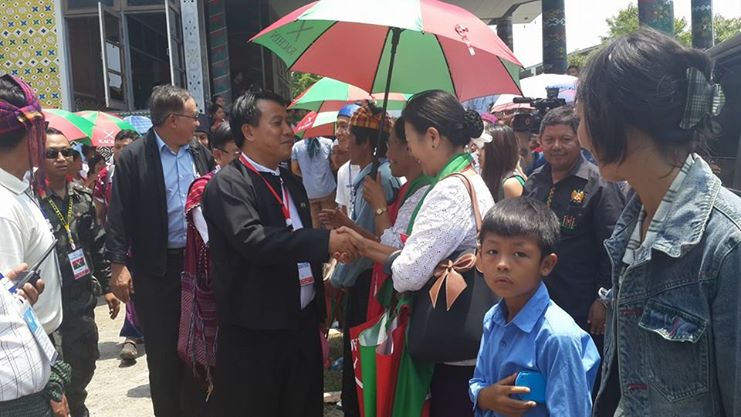
Tar Aik Bong greeting locals in Myitkyina, Kachin State, after an NCCT (National Ceasefire Coordination Team) public consultation on 15 May. (Photo: Tar Aik Bong)
BL: PSLF/TNLA is a member of the UNFC. In what way does the UNFC membership support the PSLF/TNLA struggle?
The United Nationalities Federal Council- UNFC is our ethnic nationalities armed groups’ alliance that represents almost all political and military wings of the Ethnic Armed Resistance Groups (EARGs), including PSLF/TNLA. The UNFC allows its members to have bilateral ceasefire agreements with the military government, but for political issues, the member organizations need to work together under the UNFC.
The aims of the UNFC are to establish the country as a federal union, in accordance with a federal system, acceptable to the majority of the constituent states, and with the federal army composed proportionally of members of the nationalities in the union, under a federal constitution. Therefore, all the UNFC members have accepted that they are members of the federal army and they have the duty to also help one another in military matters, under the policy of UNFC, which is empowered to carry out the political and military programs, laid down by the UNFC Congress.
TAR AIK BONG
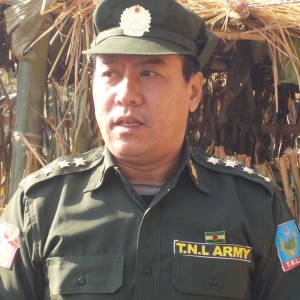 I joined the former Palaung State Liberation Army or PSLO/PSLA in August 1987. In October 1988, PSLO sent 5 delegates, including me, to NDF headquarters to Karen state to serve NDF as PSLO delegates. It took us three months on foot to reach the Thai-Burma border, as there was no other means of transportation. In April 1991, our mother organization, PSLO signed a ceasefire agreement with the SLORC/SPDC. Some of the members, including myself, refused to return to our mother organization and formed the PSLF on the 12th of January 1992. I am one of co-founders of the PSLF. From 1992 – 1995, I served as a PSLF Central Committee member and took responsibility for the communication line, called intercept. In 1996, I became joint General Secretary of PSLF. In 2001, I was elected as General Secretary of PSLF. In October 2009, at our third congress, I was elected as the Chairman of PSLF and we formed the military wing of the TNLA. I am also one of the co-founders of TNLA.
I joined the former Palaung State Liberation Army or PSLO/PSLA in August 1987. In October 1988, PSLO sent 5 delegates, including me, to NDF headquarters to Karen state to serve NDF as PSLO delegates. It took us three months on foot to reach the Thai-Burma border, as there was no other means of transportation. In April 1991, our mother organization, PSLO signed a ceasefire agreement with the SLORC/SPDC. Some of the members, including myself, refused to return to our mother organization and formed the PSLF on the 12th of January 1992. I am one of co-founders of the PSLF. From 1992 – 1995, I served as a PSLF Central Committee member and took responsibility for the communication line, called intercept. In 1996, I became joint General Secretary of PSLF. In 2001, I was elected as General Secretary of PSLF. In October 2009, at our third congress, I was elected as the Chairman of PSLF and we formed the military wing of the TNLA. I am also one of the co-founders of TNLA.
Our Ta’ang people have been waging an armed struggle reaching almost 52 years, but our political aspirations are yet to be fulfilled. They are still a dream existing in a far away place. We are struggling to defend ourselves against the unjust offensive attacks of the government military regime with a just war. On the other hand, we will holding arms until and unless we can enjoy equal rights and rights for self-determination. We are just fighting a battle in defense for our dignity, for freedom and for justice.
The Burmese military are still launching military offensives in our Ta’ang regions and northern Shan State to assert control over the region. The intensified attacks by military clearly show that they are not willing to gain internal genuine peace or to recognise ethnic political rights.
Today so-called civilian government is talking about peace but on the other hand, its military dictators are still conducting an unjust war, oppressing civilians and perpetrating systematic and large-scale human rights violations, especially in our Ta’ang areas.
I would like to promise all of you that I, together with the Ta’ang patriotic, will continue our armed struggle until we attain our political goals on establishing genuine federal union that guarantees Ta’ang national equity and the right to self-determination. At the same time, we will try our best to protect you and try our best to fight against drugs in our areas until they become drugs free areas and afford better opportunity to our future generations.
I believe that without having cooperation, unity, and collaboration among our Ta’ang people, we cannot reach these political goals in their full-scale. We all have a national responsibility through our national cause of freedom and justice to show strong participation from all sides and from all places. We need your strong support for your national liberation movement by all means. Therefore, I would like to urge you all that under the divide-and-rule system of the military regime, we should seriously take care of our cooperation among our Ta’ang organizations and I urge you to continue your backing of the PSLF/TNLA political and military activity until we achieve our political goals.
Since we fight for equality, we ethnic groups together should not discriminate among our resistance groups, whether big or small, whether strong or weak, and regardless of ethnic population or the area of our territories, but we should seek unity and we should seek out a common strategy to be successful.
Therefore, I would like to push for unity within an organization and within our alliance front, while working for our common political objectives. I would like to suggest we should pursue practical and flexible means but with a zealous spirit and a committed mind. Finally, we will only find a victory through our united efforts.
As well all know, the prolonged civil war in our country has been raging aggressively recently because the Burmese military regime who are seeking only for their interests has fueled war unilaterally. The civil war has been intensifying because they have no intention to solve political problems by political means and use superficial talks and sham ceasefire as tactics to divide and rule ethnic forces and to take advantages on ceasefire process. I believe they will continue their military offensive in our ethnic areas, to prolong their military control and to intensify their systematic practices of Barman chauvinism.
If we all ethnic armed groups can unite, then, we can smoothly compromise our political rights with military-backed government easily and quickly. We all have to keep in mind that the long policy of military government is divide-and-rule. The government divide-and-rule policy is still successful. They, the government, will continue to carry out their divide-and-rule policy within individual organization or collectively on the alliance front. That is why unity is the most important factor for our ethnic nationalities.
If Thein Sein government and his Burmese army really want to address the political, social, economic, education and health crises the people are facing today, they must stop their harassment and oppression against the ethnic people and they must acknowledge the political rights of the ethnic people for their full autonomous rule to designate their own future. Additionally, the Burmese government must hold genuine political dialogue with ethnic armed groups, including the PSLF/TNLA. Solving political problems, by the means of political dialogue, is the only way to reach national reconciliation and lasting peace leading towards a democratic federal union with guarantee of basic political rights with national equality and self-determination in Burma. Therefore, in order to solve political problem and crisis in Burma, I ask Thein Sein and his Burmese army to stop military offensives against the ethnic nationalities, to be sincere and honest on negotiations for nationwide cease-fire agreement, and to start meaningful political dialogue with all ethnic armed groups, regardless on whether they are big or small, as soon as possible. Otherwise, the long-lasting civil war of the country will never end.
Currently the Burmese military has been increasing its troops inside Ta’ang areas in northern Shan State and intensified armed battles have broken out in Ta’ang areas since U Thein Sein became President in 2011 until now.
The Burmese government troops are not only extending its militarization in the region, but also the Burmese officials have confiscated farm land off local farmers for the construction of its military camps/bases and administrative buildings some with inadequate compensation and others with no compensation whatsoever. They committed various human rights abuses against our Ta’ang people such as conscripting for porters, forced labors, forced conscription of properties, extra judiciary arrests, killing, raping, forced marriage, using force labor on Burmese military farms and road construction. The whole situation makes Ta’ang people more vulnerable and echoes a lack of security under a lawless situation.
Most international communities do not see the contradiction between government policy and local on the ground realities. The government’s image abroad is good and gaining recognition with the easing and lifting of economic sanctions as a result of the ceasefire but for the ethnic armed groups, we are getting nothing except more and more government troops encroaching in their territories. The government hasn’t actually made any concrete steps towards withdrawing its army battalions from ethnic areas according to the points specified in their ceasefire agreements. What we see in the area is that instead of withdrawing or reducing their army, they are reinforcing and establishing their army camps more in territories and in armed conflict areas as well.
The major problem between the ethnic armed groups and Burmese military is the future country constitutional system. Ethnic armed groups have proposed a federal system and one army system under federal constitution, but the government and its military delegation disagreed on such a proposal and will continue to back a “one nation and one national armed force” system under 2008 constitution.
To get the approval of the people on 2008 constitution, the government wisely chose the right time; of cyclone Nargis hitting lower Burma. While tens of thousands of people from storm-hit delta areas were losing their lives, the government carried out a referendum. About 6 million people signed to amend some articles in 2008 constitution, the military-turned government and parliament neglected to amend on these main articles. The ethnic nationalities strongly remark that the 2008 constitution could not build the real Democratic Federal Union of Burma.
Genuine peace or lasting peace now depends on an honest and enlightened response from the Burmese government and it’s military. Without genuine peace, there will be meaningless outcomes or won’t be freedom, justice, and development in Burma as well as in ethnic states. Therefore, by helping us, I would like to urge and invite the international community, international media, and journalists to come and see the real picture in our areas, so that they can learn the real situation rather than only listening to the propaganda of the government.
Thank you.
Above answers and messages were written by Tar Aik Bong in email correspondence with Burma Link.

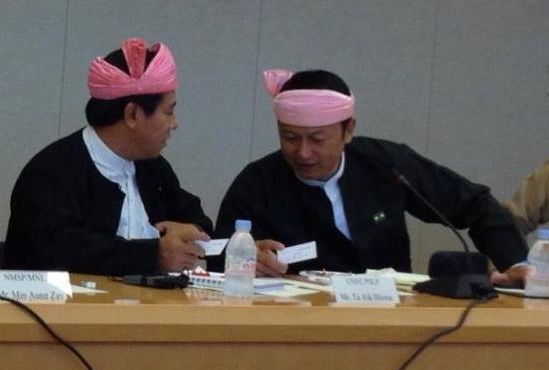
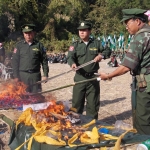

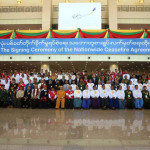
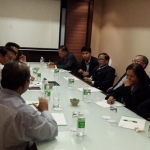

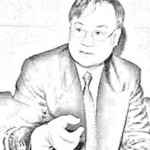
[…] Message to Ta’ang People: ‘We will try our best to protect you’ […]